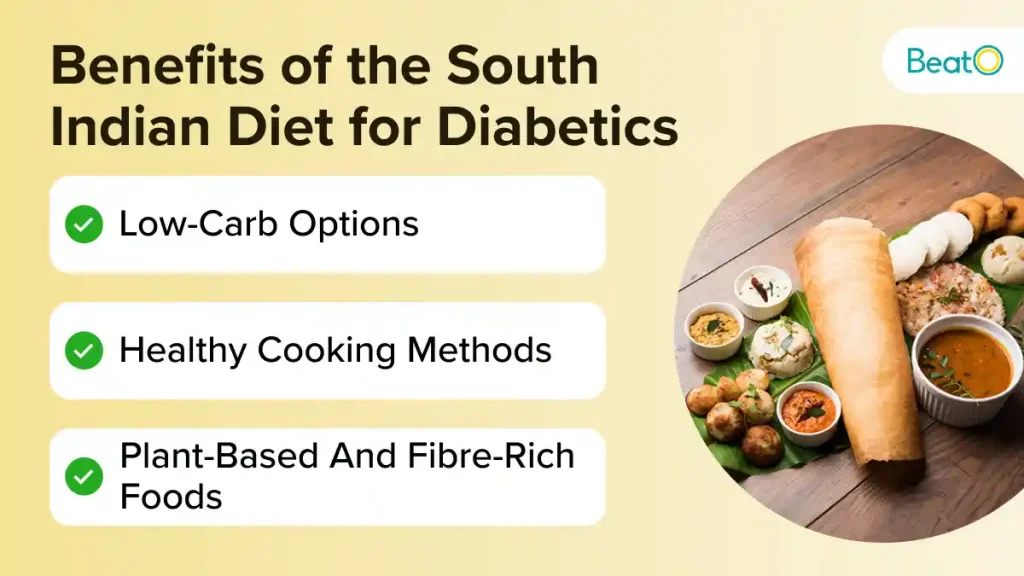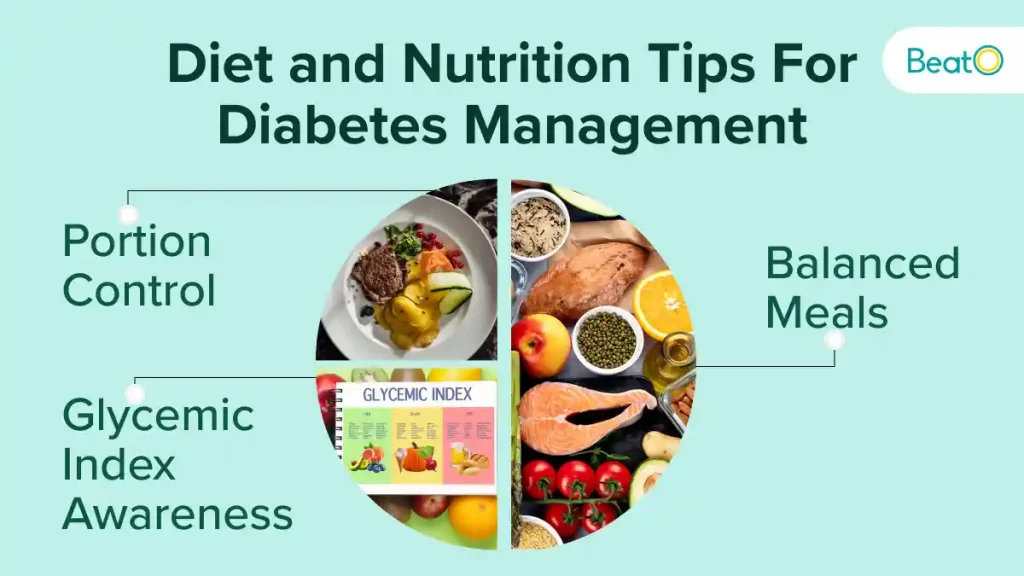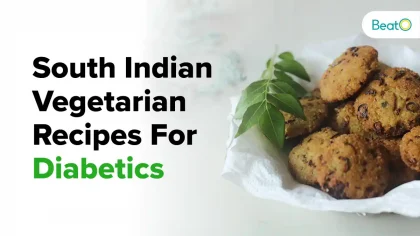We know diabetes management for South Indians can be a tricky task. South Indian diabetes management requires careful consideration of traditional dietary habits, lifestyle factors, and cultural practices. Diabetes is a disease that requires being cautious with the kind of foods one eats, the level of physical activity one undertakes, and how one takes care of his or her body in general. One must follow a well-planned diet, which comprises taking proper meals, controlling portion sizes, and being conscious of glycemic index levels. Being in South India and having access to a balanced diet that provides many plant-based and fibrous products, there are many opportunities to practice a healthier diet. Moreover, proper cooking methods and the application of spices and herbs are also worth mentioning, as they may help regulate diabetes.

In this article, we are going to learn about South Indian diabetes management plan, including diet control, diet plans, exercise and dietary changes, and the use of traditional herbs and Ayurveda. We will also discuss the possibility of using some natural products in treating diabetes in conjunction with conventional medicine.
Buy Now: Spandan Portable ECG Monitoring Device
South Indian Diabetes Management Diet Chart
Breakfast Options
- Ragi Dosa: Made from finger millet, it’s a low-GI breakfast option that helps in controlling blood sugar levels.
- Oats Upma: A healthy variation of the upma, which is made with oats and mixed vegetables for additional nutrition.
- Idli: Use a mix of brown rice and lentils for a healthier, low-GI version of this popular dish.
- Vegetable Pongal: A tasty preparation of Moong Dal cooked with vegetables, which is rich in protein and fibre.
Also Read: Smart Eating with Diabetes: Benefits Of Chickpeas
Lunch and Dinner Ideas
- Brown Rice with Sambar: Choose brown rice over white rice and accompany it with a healthy sambar made with a lot of vegetables.
- Millet-based Dishes: Bajra (pearl millet) and jowar (sorghum) can be used in the preparation of rotis or dosas as an option to obtain a low-GI foodstuff.
- Fish Curry: Take fish, especially fatty fish like salmon or mackerel, and try to take omega-3 fatty acids in your diet.
- Vegetable Stir-fry: Utilise a colourful variety of vegetables that need to be stir-fried with spices and very little oil.
Healthy Desserts and Sweets
- Ragi Halwa: This is another of the sweet dishes that can be taken in limited quantities and is prepared with ragi flour.
- Fruit Salad: This comprises low-GI fruits such as berries, apples, and pears, with a splash of lime juice.
- Jaggery-based Sweets: Substitute normal sugar with jaggery or natural sweeteners while preparing your favourite sweet dishes.
Buy Now: TruNativ Everyday Protein
Special Occasions and Festive Foods
- Bisi Bele Bath: Tasty rice, lentils, and vegetables can be cooked with brown rice for a better and healthier type.
- Payasam: This festive sweet should ideally be made with low-GI ingredients, such as millet and natural sweeteners.
- Stuffed Vegetables: Some vegetables, such as bell peppers and eggplants, can be stuffed with various spiced lentil mixes to provide a much-needed healthy meal in the context of a festival.
Also Read: Discover the Amazing Fenugreek Seeds Benefits
Healthy Snacks:
- Vegetable salads
- Fruit salads with low-sugar fruits
- Steamed or boiled veggies
- Steamed dhal vadas
- Microwave papads topped with veggies
Foods To Avoid:
- Deep fried items
- Coconut-based curries and chutneys
- Oily curries like kara kuzhambu
- Dishes high in oil and rice, like biriyani and pulao
Benefits of the South Indian Diet For Diabetics

Plant-Based and Fibre-Rich Foods
A South Indian diet contains a large number of vegetarian dishes. Fruits, vegetables, and whole grain products are popular, and many include high levels of fibre. Fibre also plays a crucial role in the management of blood sugar levels because it slows down the digestion and absorption of carbohydrates.
Low-Carb Options for Better Blood Sugar Control
There are several low-carb options in South Indian food. Some foods, such as dosa, which is prepared from fermented rice and urad dal batter; idli, which is steamed rice cakes; and some curries, contain less amount of carbohydrates. This assists in regulating the blood sugar level among diabetic individuals.
Healthy Cooking Methods
Most South Indian dishes are fermented, stewed or cooked in some other way, and very few are fried. Fermentation makes food better in terms of its nutrient content and is considered to have positive effects on the gut. Stirring and boiling does not change the nutritional content of food and help to prepare healthier meals with less fat.
Also Read: Benefits Of Coconut Water That You Need To Know
Rich in Spices and Herbs
South Indian food consists of hot spices and other herbs, which include turmeric, curry leaves, and fenugreek. Besides enhancing the taste, they possess anti-inflammatory and blood sugar-regulating qualities.
Lean Proteins
Some of the lean proteins that are common in South Indian food include lentils, legumes and some fish. These proteins are used in the building and sustaining of muscles as well as in the provision of a constant supply of energy.
Moderate Use of Healthy Fats
Most of the South Indian meals include coconut or other oils, but not excessively. This assists in the regulation of calories and fats, which are useful for diabetics.
Herbal and Natural Remedies For Diabetes
Ayurvedic Practices for Diabetes Management
According to Ayurveda, an Indian system of medical science, there are several techniques to treat diabetes as well as some natural cures. They include dietary alterations, the use of herbal products, and changing lifestyles that help to bring about harmony in the doshas.
Common South Indian Herbs and Their Benefits
- Fenugreek: Helps reduce blood sugar levels by improving insulin sensitivity in the body.
- Bitter Gourd: It is well known for its blood sugar-lowering properties.
- Cinnamon: It can help lower fasting blood sugar levels and improve insulin sensitivity.
- Turmeric: It contains curcumin, which is abundant with anti-inflammatory and blood sugar-regulating properties.
Integrating Natural Remedies with Modern Medicine
Integrating the use of herbs with traditional medication is therefore the best way to manage diabetes through a holistic approach. It is also good to seek advice from physicians when using such supplements, especially if they are on other prescribed medicines.
Also read: Patharchatta Benefits You Might Not Know About
Tips For Diet and Nutrition

Balanced Meals
The basic approach to South Indian diabetes management is through diet control, more specifically through nutrition. Foods consumed by the traditional South Indian population are often high in carbohydrates, therefore raising the glycemic index. Proper dieting that involves taking meals with proteins, fats, and fibre can enable one to tackle these fluctuations. Introduce lentils and chickpeas because they are sources of protein and fibre that help control hunger and prevent sugar dips. The incorporation of brown rice, millet, and quinoa as compared to white rice also assists in controlling type 2 diabetes.
Portion Control
The second area of focus in South Indian diabetes management tips is portion control. Portion control is the key to losing weight; it doesn’t matter that you are eating a particular food, it matters that you are taking the right amount of that food. Portion control is the key; you can relish all the South Indian dishes you want without having a nasty impact on your blood sugar levels. Splitting into portions and using small plates and bowls is also an ideal approach to portion control. Consuming food in small portions in several places instead of taking large meals can also assist in stabilising blood sugar levels.
Glycemic Index Awareness
Being aware of foods with a high glycemic index (GI) in a South Indian diabetes management diet plan is key to managing diabetes. Low GI foods have a slow and progressive effect on the levels of blood sugar in the body as compared to high GI foods. Choose foods that fall between the GIs of 55 and 70. For instance, replace the normal idlis and dosas made from refined white rice with those made from whole grains/ragi (finger millet). Intake of vegetables such as bitter gourd, fenugreek, and greens is good for diabetics since they have a low GI rating.
Also read: Bajra Pearl Millets Benefits: Good For Heart & Gut Health
Exercise and Physical Activity
Regular Physical Activity
Physical activity is one of the most important aspects for South Indian diabetic patients. Physical exercise is also a way of reducing insulin resistance and managing blood glucose levels. Make sure that you engage in at least 30 minutes of moderate-intensity exercises like brisk walking, jogging, or cycling a day. Even simple forms of exercise, such as dancing the traditional South Indian dance like Bharatanatyam or even folk dances, can also be engaging and enjoyable.
Yoga and Meditation
Relaxation techniques such as yoga and meditation form a critical part of diabetes care in South India. Yoga poses, including Surya Namaskar and others, have been shown to increase metabolism and, therefore, weight control. It has been found that techniques such as meditation help to control stress, which is known to cause elevated levels of blood sugar. Yoga and meditation are therefore effective and comprehensive ways of managing diabetes.
Lifestyle Changes For Diabetes Management
Stress Management
Stress management is an important determinant of South Indian diabetes management plan. Chronic stress results in hormonal imbalances and increased blood glucose concentrations. Participate in activities that help to combat stress, for example, practising meditation, spending time with loved ones, or doing enjoyable activities. Stress is a common problem in the world, and Ayurveda, which is a South Indian tradition, has many treatments and herbs that can deal with stress.
Adequate Sleep
Another important factor that was found to be part of the South Indian diabetes management plan is sleep. This is because sleep deprivation disrupts the normal functioning of insulin in the body, hence raising blood sugar levels. Ideally, one should sleep for roughly 7-8 hours a day, but the quality of the sleep should be optimal and uninterrupted. The regularity of the sleeping schedule and the environmental conditions in the bedroom can also play a role in the quality of sleep.
Also Read: Unlocking the Potential: Is Beaten Rice Good for Diabetes?
Regular Health Check-ups
Regular health check-ups are an essential part of the South Indian diabetes management plan. Checking blood glucose, HbA1c, blood pressure, and cholesterol can help assess one’s status and make the necessary changes to the management plan. It is recommended to consult with healthcare providers more often to receive individual recommendations and identify possible issues on time.
Conclusion
Effective South Indian diabetes management plan requires a balanced approach that includes diet, exercise, and lifestyle changes. Some meals eaten by people in the South Indian region can be modified to help regulate blood sugar and incorporating physical activities such as yoga and traditional dances into regular routines can aid general health. Complementary to this, there are herbal treatments and Ayurvedic solutions, but one must not forget to consult with a licensed doctor.
Through informed decisions and the application of the tips and resources highlighted, people of South Indian origin diagnosed with diabetes can live healthily, minimise risks of complications and enhance their quality of life. It must be noted that diabetes is a lifelong condition that does not have a cure, but this should not deter patients from living their best lives.
Disclaimer: The content of this article is compiled information from generic and public sources. It is in no way a substitute, suggestion, or advice for a qualified medical opinion. Always consult a specialist or your own doctor for more information. BeatoApp does not claim responsibility for this information.
Throw out your non-verified glucometer and try the BeatO clinically approved smartglucometerkit. Check your blood sugar level instantly. Try out the BeatO diabetes care programfor a more organized healthcare routine.
Looking for a seasoned diabetologist? ChooseDr. Navneet Agarwal, an expert with 25+ years of experience. His specialisation in diabetology and obesity management provides personalised care. Elevate your health with a doctor’s recommendedglucometer, buy now.




